Introduction
- Hispanics and Latinos have the highest propensity for heart related diseases in the society.
- They are at a very high risk of developing diabetes, obesity, and hypertension.
- A communal intervention is necessary to alleviate the issue.
- There is a need to create awareness among the Hispanic and Latinos about the high risk they face with reference to the development of heart related diseases.
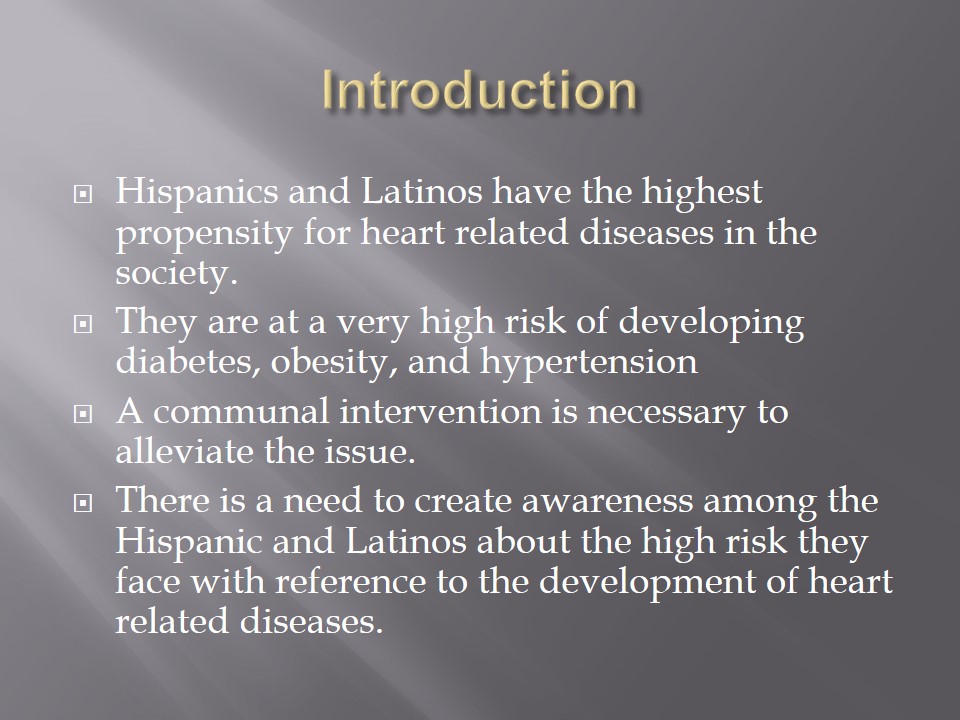
Demographics
- Data collected from Westminster, CO reveals that 75% of Hispanics and Latinos are overweight.
- 21.3% of the Hispanic and Latinos do not engage in any physical exercises.
- 30% of the Hispanic and Latinos in the city have already been diagnosed with diabetes.
- 20.5% are smokers, and this increases the risk of developing heart related illnesses (Westminster (city), Colorado, 2015).
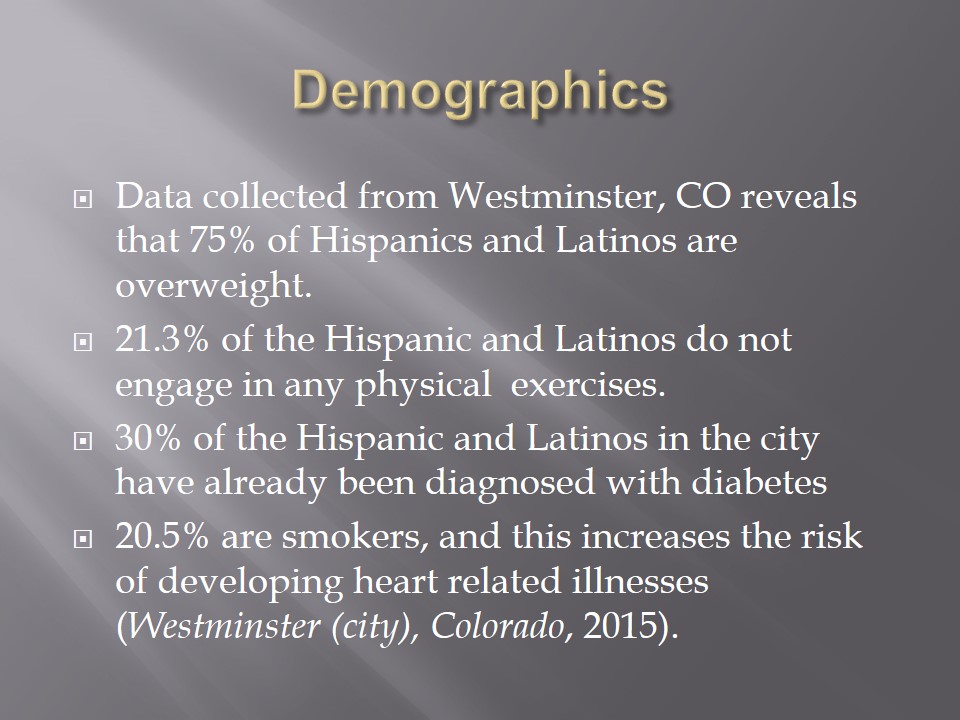
State level statistics
- 25% of Hispanic and Latinos in Colorado are obese.
- Diabetes is one of the common diseases among the Hispanics and Latinos in the state.
- Only 55.8% of the population are adequately educated (Graham, 2013).
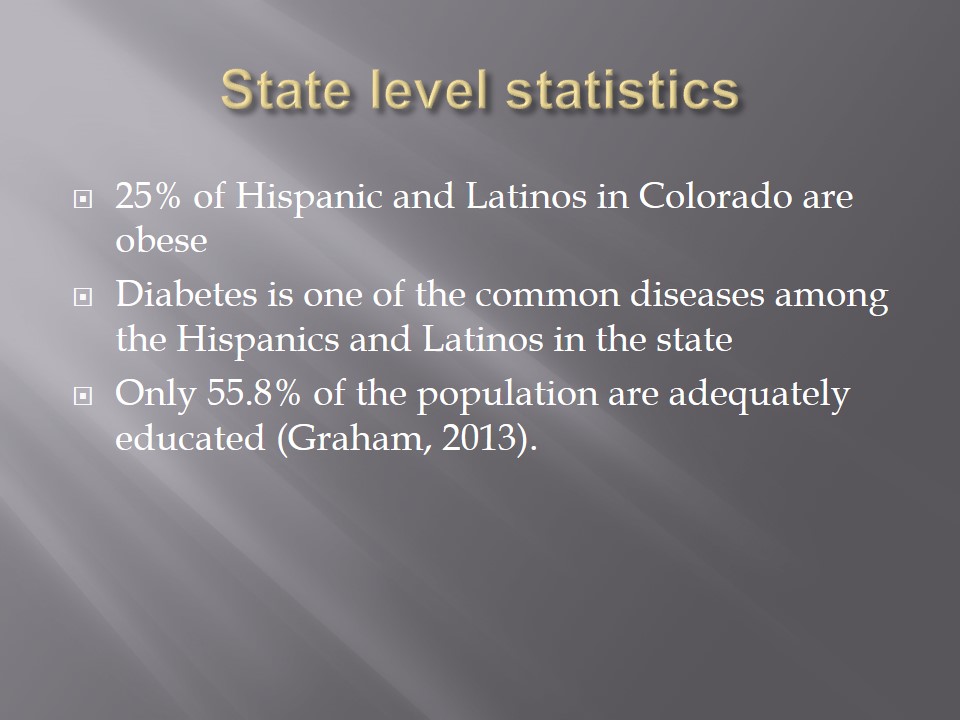
Proposed intervention
- An inclusive community-based intervention program.
- The program will involve the members of the community, physicians dealing with heart related diseases, and the authorities in the State.
- A multifaceted approach to ensure there is a comprehensive awareness program to fight against hypertension.
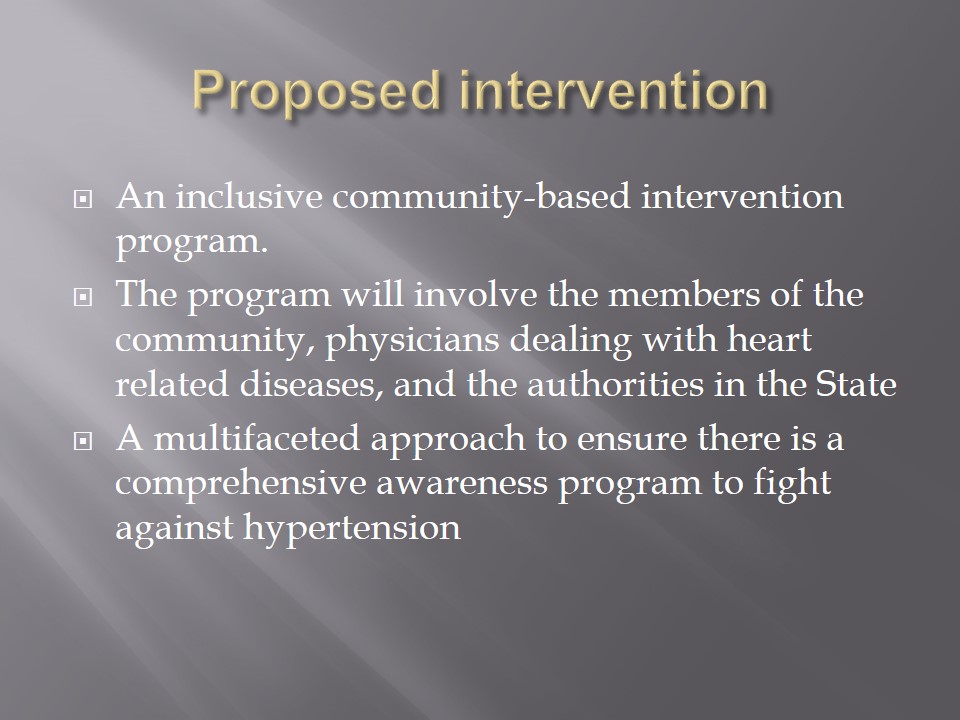
Objectives of the intervention plan
- To create awareness about the risk of developing heart related diseases to the Hispanic and Latinos.
- To involve hypertensive, obese, and diabetic members of the society to educate Hispanics and Latinos about the management of these illnesses.
- To involve health care physicians in the community in educating the Hispanics and Latinos about preventing heart related diseases.
- To compel the authorities to provide affordable, preventive health care for Hispanics and Latinos in the society.
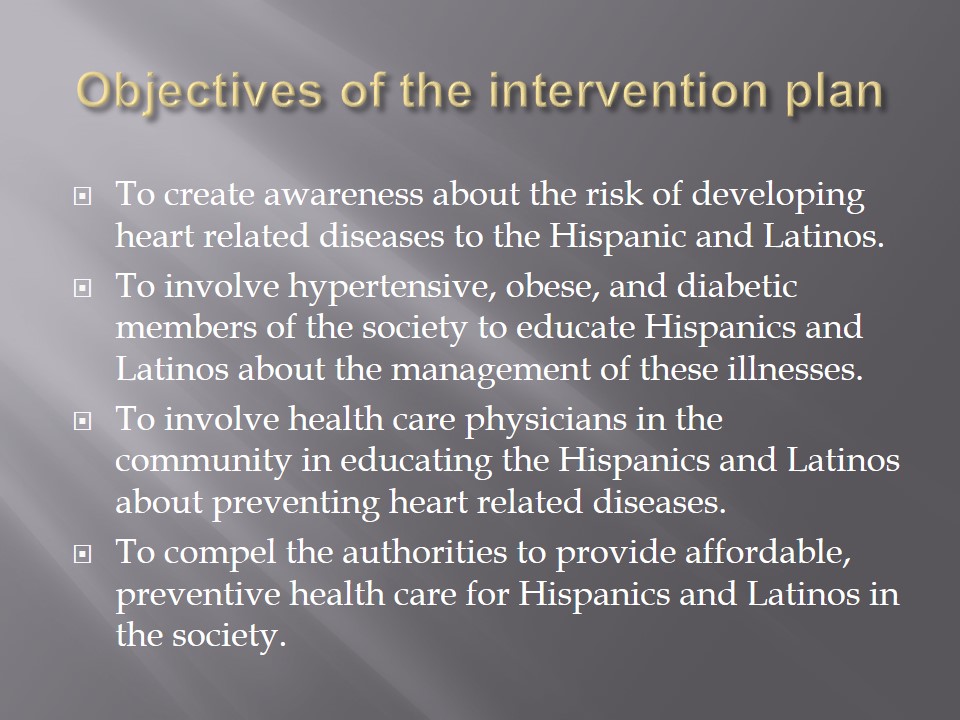
Targeting the community
- The proposed intervention plan will be applied in the Westminster, CO. With the help of the authorities, the plan will be adopted in the entire state.
- The intervention will take place over 2 years to ensure the entire population is covered.
- The member of the community will be reached through a mobile campaign to recruit volunteers for the program.
- The program will involve local institutions like churches, physician’s offices, and other local resources that can help in harnessing a large following for the program.
- The program will particularly target the members of the community that are living with heart related diseases.
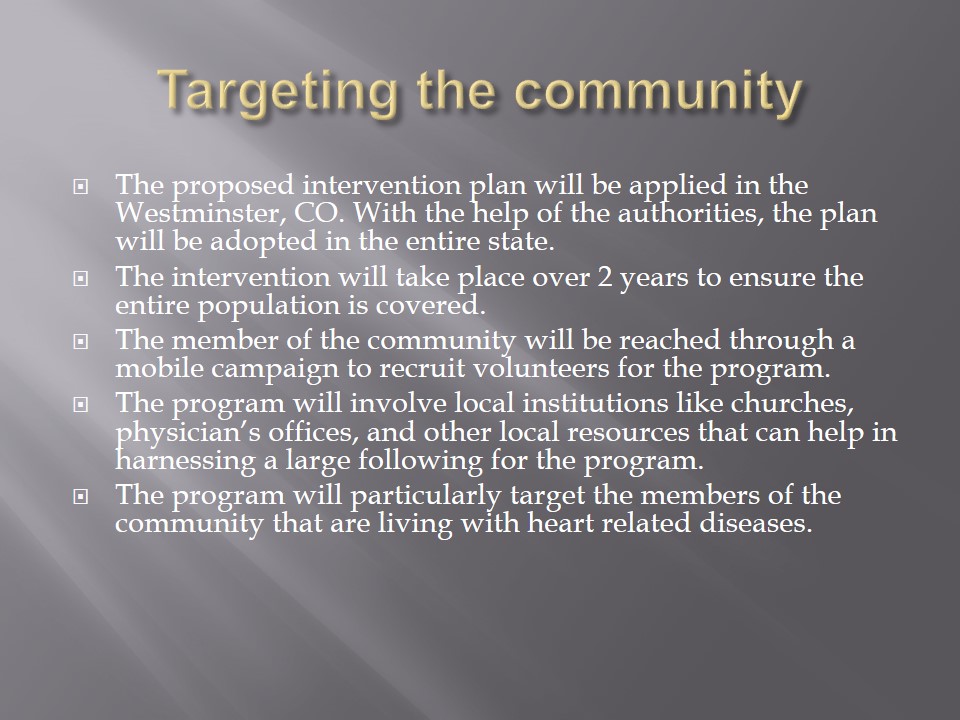
Role of the CHN
- The role of the CHN in this program will be the development of an educational platform to help the Hispanics and Latinos come to terms with the factors that enhance their risk for developing heart related diseases.
- The CHN will also be in charge of developing a plan for the ambulatory clinics that will be used to diagnose people from different parts of the city.
- The CHN will be charged with the collection of demographics on the number of people in the city that have heart related diseases, and those that are at a high risk of developing the diseases.
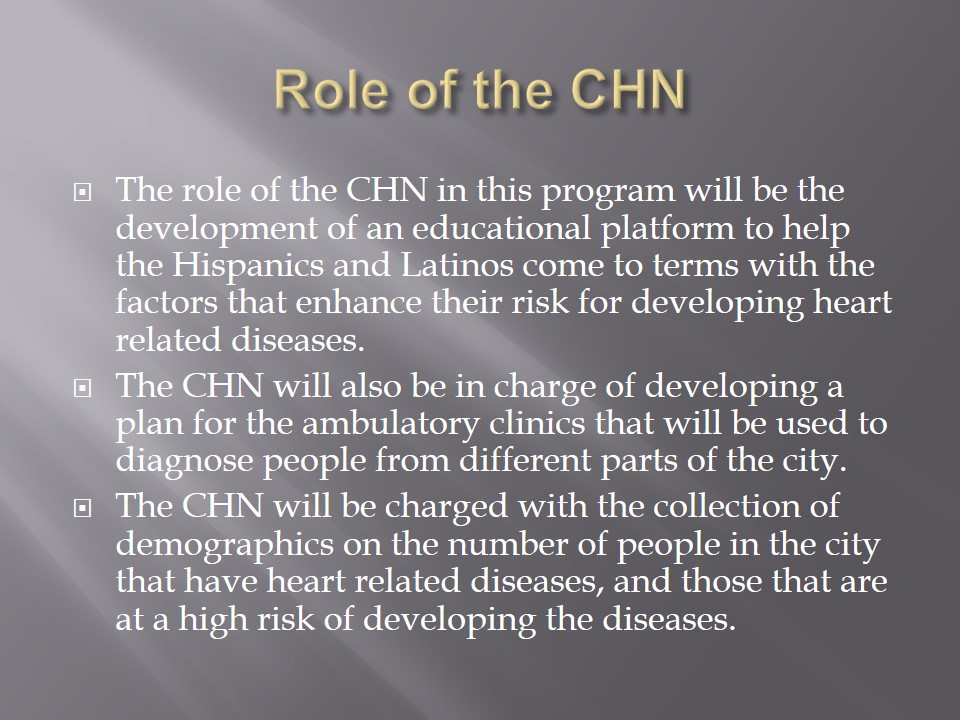
Primary level of intervention
- The program will aim at reducing some of the causal factors of heart relate diseases.
- The CHN will provide information about some of the causal factors like smoking and involve the community in compelling its members to stop smoking.
- The CHN and other physicians in the program will also educate the members of the community about healthy lifestyles, including healthy diets and regular exercising.
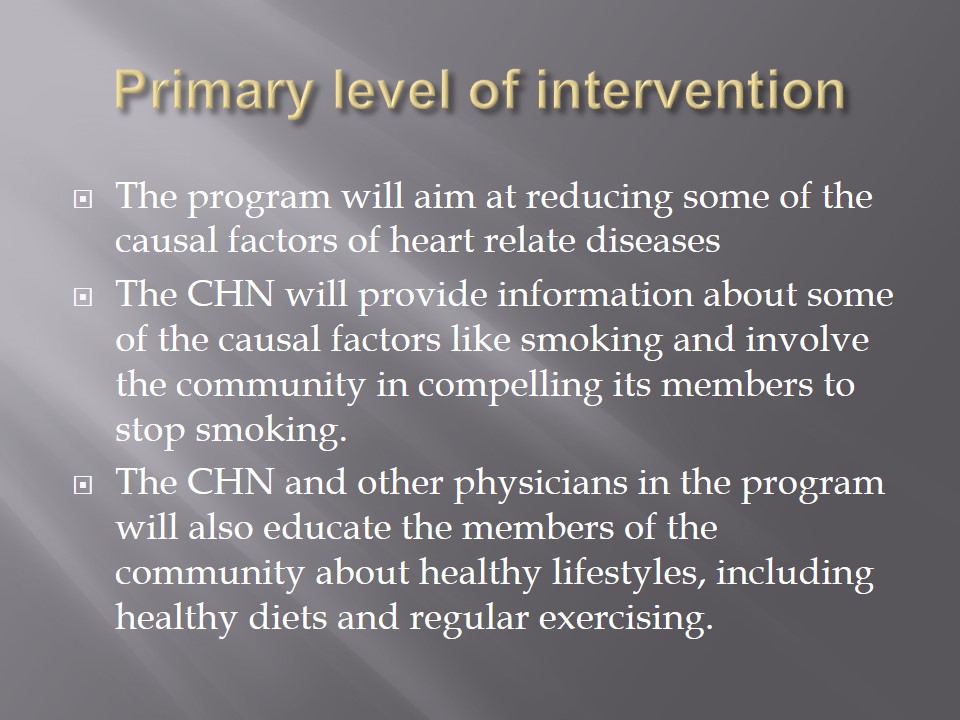
Secondary level of prevention
- Mobile clinics will be availed to provide free health care services to the high-risk population. The clinics will drive around the neighborhoods of the Hispanics and Latinos.
- Hispanics and Latinos will be urged to visit the clinics for tests and diagnosis of heart related diseases.
- Nurse educators will be provided to help the diagnosed members of the community to manage their respective illnesses.
- The CHN will visit the diagnosed members of the community to follow up on their health management processes.
- The community will be provided with lists of symptoms that indicate the presence of certain heart related diseases to ensure the illnesses are detected in time.
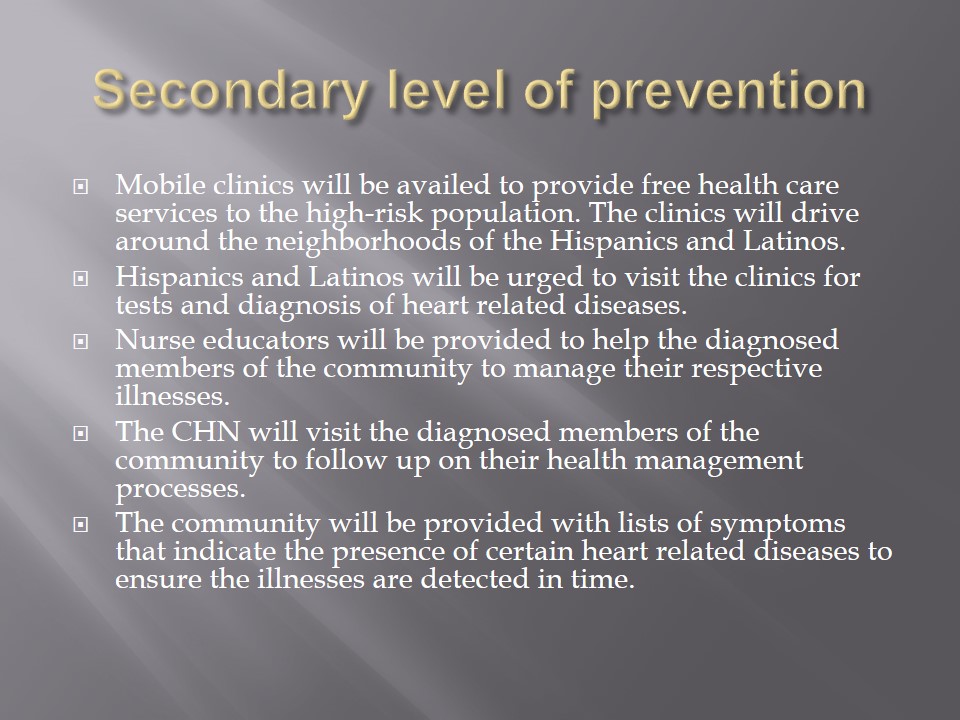
Tertiary level of prevention
- Heart surgeries for patients with serious heart conditions will be provided at an affordable price to alleviate their conditions.
- Any other necessary surgical procedures to prevent heart related diseases from threatening the lives of the members of the target population will be provided by experts in the same field.
- The authorities will be compelled to finance the development of public health care facilities with a specially equipped unit to deal with different heart related diseases.
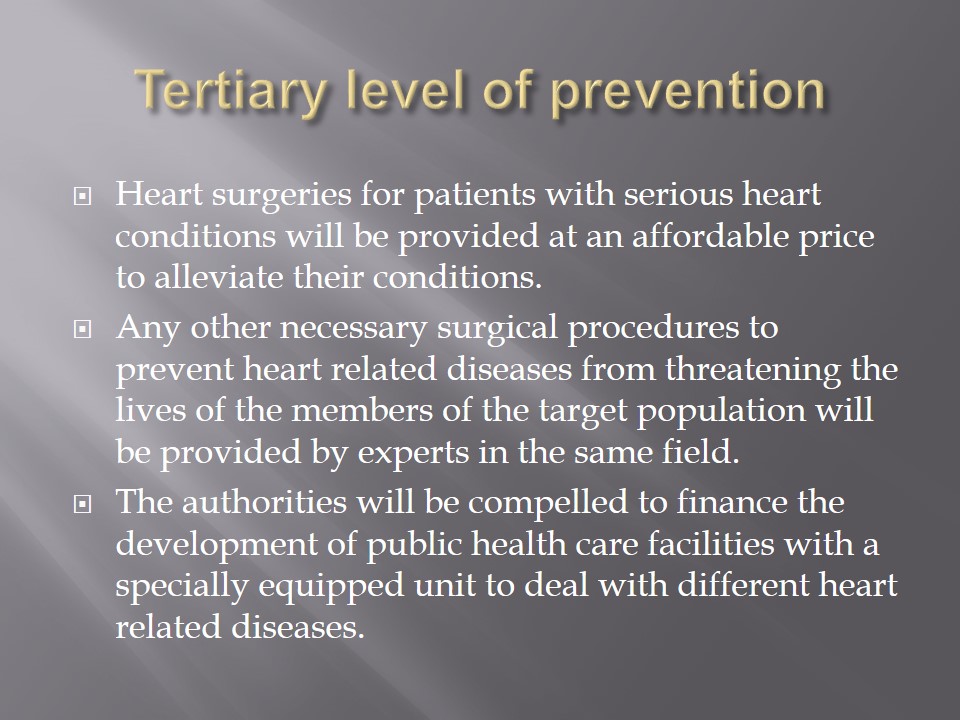
Intervention justification
- Based on the check it, Change it intervention program proposed by Shah et al. (2013), this program is bound to provide a comprehensive prevention plan.
- The plan involves the identification of the causal factors, establishing the affected population, and developing a plan to help them get better (Shah et al., 2013).
- It covers the primary, secondary, and tertiary levels of prevention; hence, it has a high probability of reducing the risk of developing heart related illnesses among the Hispanics and Latinos.
- The intervention program also focuses on alleviating specific heart related diseases as proposed by Jafar et al. (2010). It will particularly focus on reducing the number of cases of Hispanics and Latinos diagnosed with hypertension (Jafar, 2010).
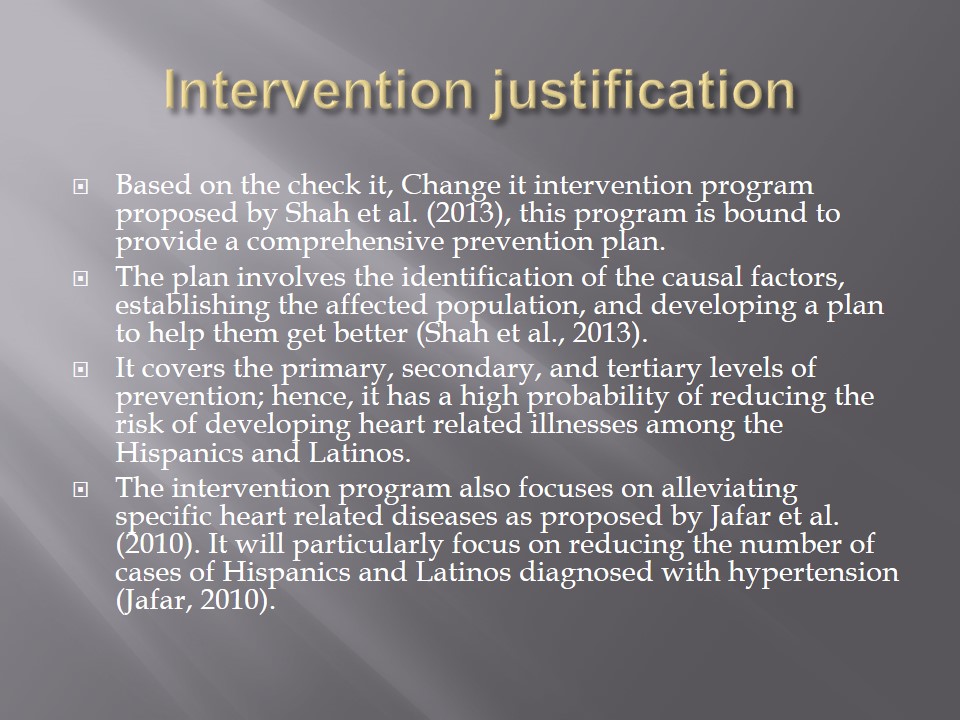
Why the intervention should be a priority
- According to Jafar et al. (2010), hypertension and other cardiovascular illnesses are the leading cause of death across the world.
- Hispanics and Latinos in Colorado are facing a very high risk of developing cardiovascular diseases that may lead to high numbers of premature deaths.
- The authorities in the state should be compelled to finance the intervention plan at different levels of the prevention program.
- There is a need for the health care system to facilitate accessible and affordable preventive health care services to this population.
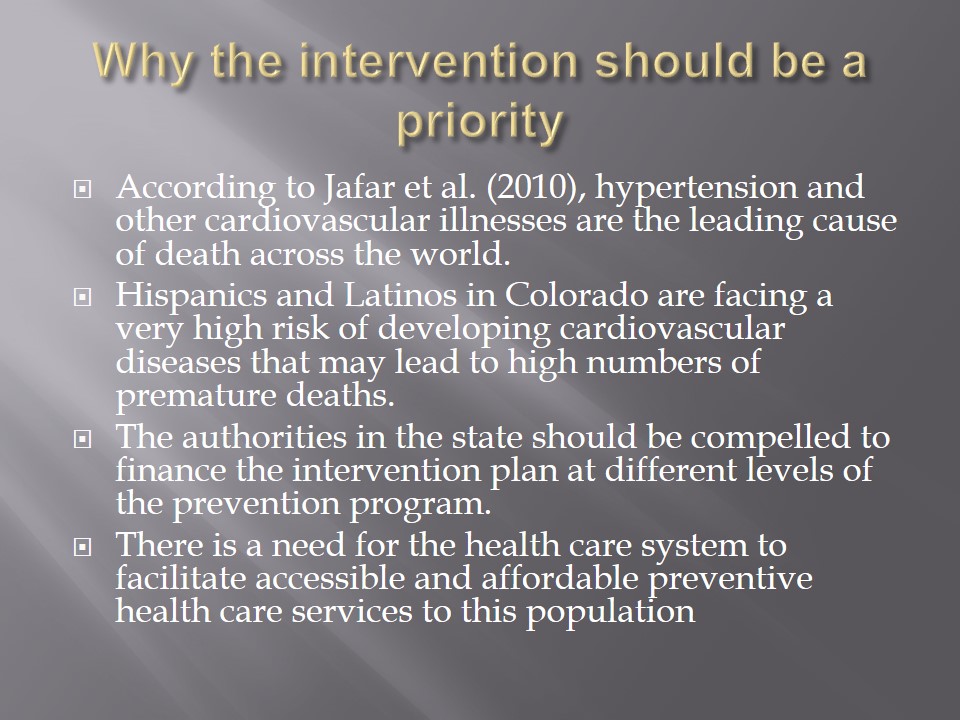
Proposed Short-term and long-term qualitative evaluation
- The short-term effect of the program will be evaluated through a survey to establish the response of the members of the community with reference to the ability of the target community to use the education provided to enhance their lifestyles.
- The long-term effect of the program will be evaluated by reviewing data on the disease management knowledge possessed by the people diagnosed with different heart related diseases.
- The ability of the members of the community to effectively identify symptoms associated with heart related diseases will also reveal the qualitative evaluation of the intervention program.
- The CHN and nurse educators will conduct regular formative and summative assessments on the target population, which will cumulatively reveal the efficiency of the program.
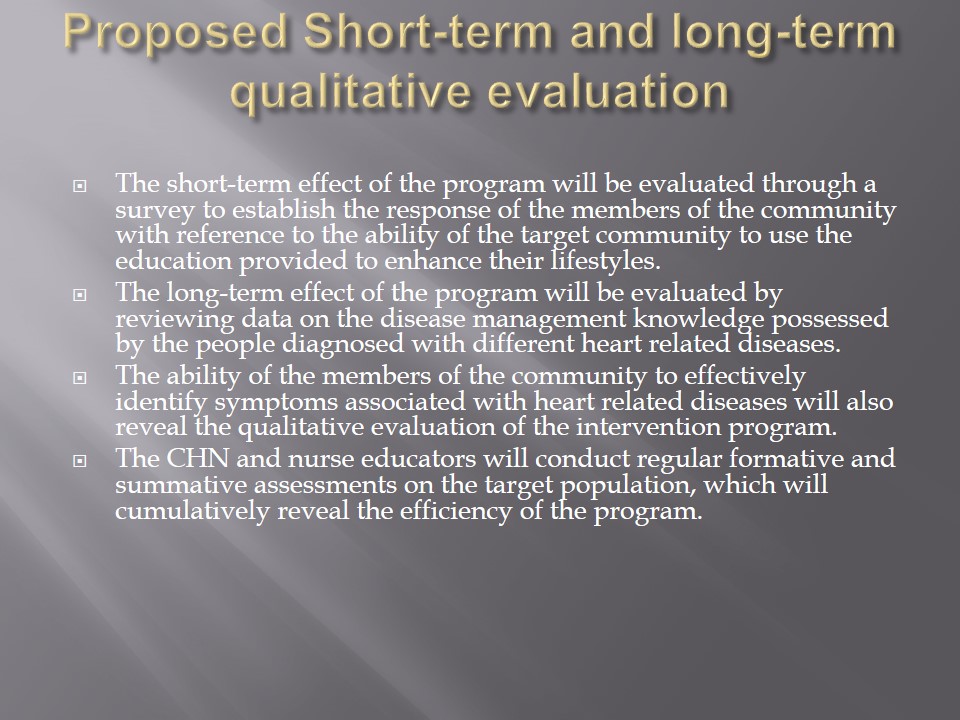
Proposed Short-term and long-term quantitative evaluation
- The number of the members of the community that will enroll for voluntary work in the intervention program will highlight its support from the community.
- Quantitative data on demographics from the mobile clinics will reveal the response of the community in voluntary access to preventive health care services for heart related diseases.
- The number of public health care facilities that will be constructed by the authorities in the state will also reveal short-term and long-term effects of the program.
- Statistical analysis of the number of Hispanics and Latinos that will be diagnosed with heart related illnesses will also reveal a trend that will be used to determine whether the intervention program will yield positive effects.
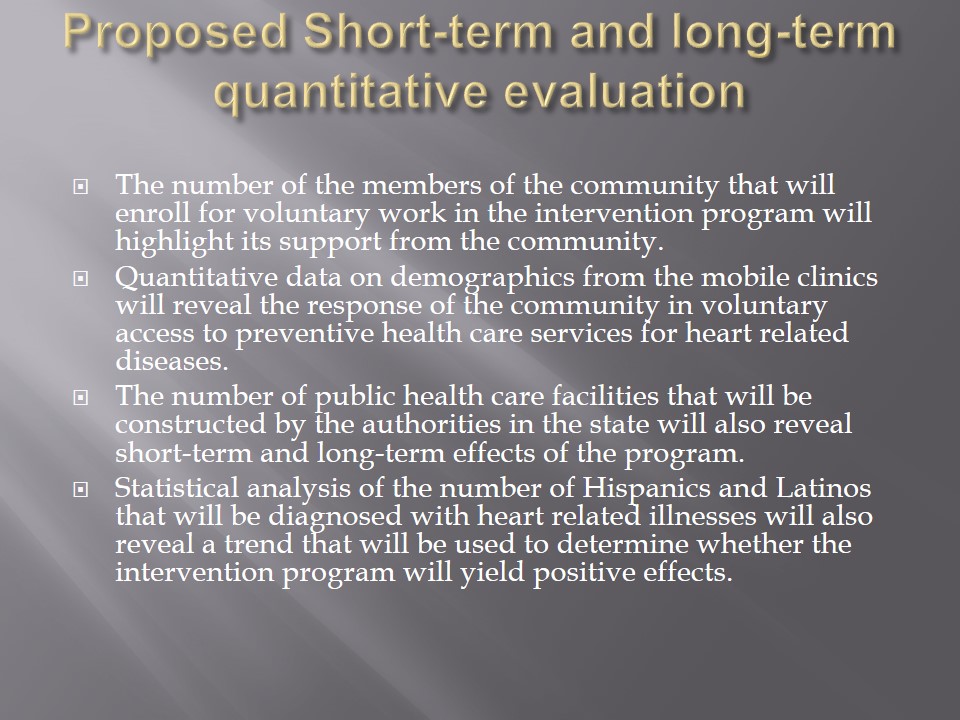
Summary
- An intervention program is required to reduce the risk level of developing heart related diseases for Hispanics and Latinos in Winchester, CO, and the entire state.
- The proposed intervention plan will require the integration of communal efforts, which will include health care experts, members of the community, and the authorities.
- Mobile clinics will be used to provide free preventive health care services.
- Nurse educators and the CHN will provide health education to the target population.
- The authorities will be compelled to develop health care facilities to provide affordable services to the Hispanics and Latinos.
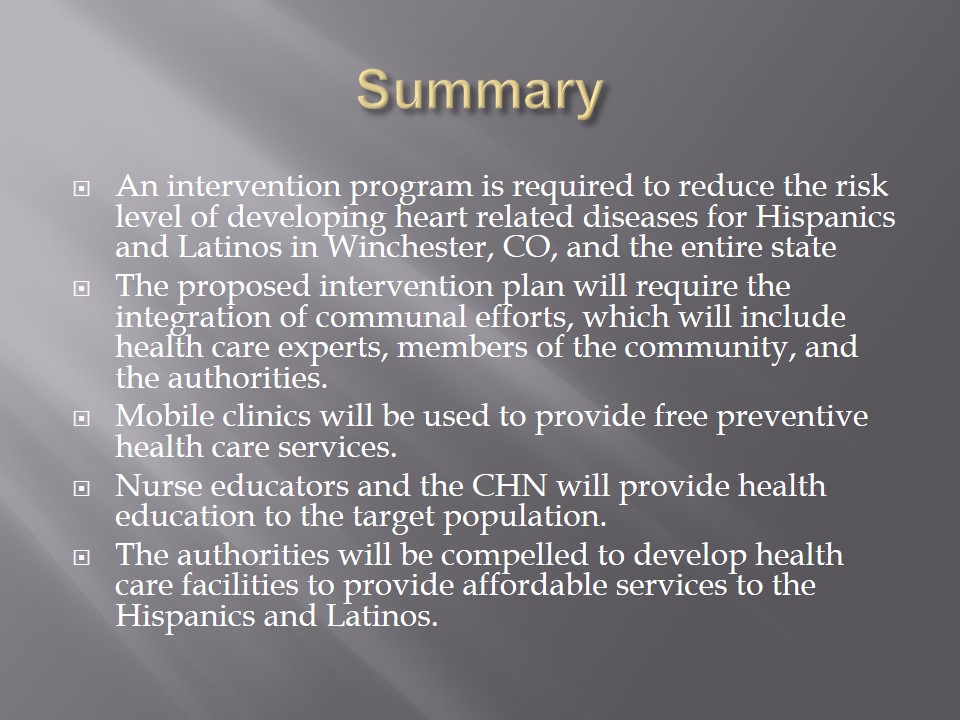
References
Graham, S. (2013). Bridging the Hispanic Health Divide. Web.
Jafar, T. H., Islam, M., Hatcher, J., Hashmi, S., Bux, R., Khan, A., & Chaturvedi, N. (2010). Community based lifestyle intervention for blood pressure reduction in children and young adults in developing country: cluster randomised controlled trial. BMJ, 340.
Shah, B. R., Thomas, K. L., Elliot-Bynum, S., Thomas, K., Damon, K., LaPointe, N. A., … & Peterson, E. D. (2013). Check It, Change It A Community-Based Intervention to Improve Blood Pressure Control. Circulation: Cardiovascular Quality and Outcomes, 6(6), 741-748.
Westminster (city), Colorado. (2015). Web.